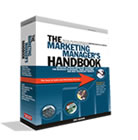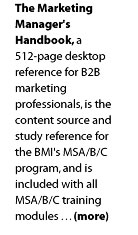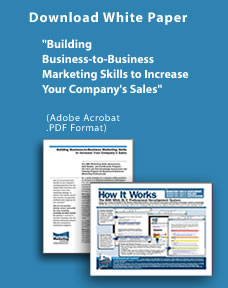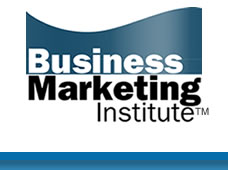


Tuesday Marketing Notes (Number 16—January 10th, 2006)
A B2B Marketing Newsletter for BMA Members
____________________________________________________________
MAKE SURE YOU CONTINUE TO RECEIVE EACH ISSUE OF TUESDAY MARKETING NOTES—CLICK HERE TO RENEW YOUR FREE SUBSCRIPTION
(NOTE: if you’ve already signed up previously at this link above, no need to do so again)
Trade Shows
Part 2: Trade Show Pre-Marketing and Deliverables: What You Need to Do Before the Show
One of the keys to a successful trade show are the important pre-show promotional steps you take before the show, to let attendees, prospects, and customers know about your company’s (or client’s) upcoming appearance at the show. Because the steps you take to promote your company prior to the show raise interest in your company and its product to prospects before they’re overwhelmed by the hustle and bustle of attending the show, pre-show promotion helps drive traffic to your booth from qualified prospects.
Since your pre-show promotion must often be started well in advance of the show (about 6-8 weeks), it’s often lost in the stampede of the marketing manager’s (or agency’s) other day-to-day marketing projects.
Nonetheless, experienced B2B marketing pros know the importance of pre-show promotion, and will make the time to get it done, without turning these projects into last-minute fire drills for their agencies or outside marketing consultants.
Your Pre-Show Mailing
A pre-show mailing is the most effective way to get the word out on your company and its product before the show, by reaching attendees in the relative peace and quiet of their own offices. By imprinting your company’s sales message in the mind of your prospect ahead of the show, you give your company a better chance of cutting through the noise and confusion created by the hundreds of other companies who will be competing for the prospect’s attention once the show is underway.
The goal of pre-show promotion is simple:You want to let show visitors know about your product and your company, by giving them just enough informationabout both, so they’ll remember your company when they’re at the show. As a show exhibitor, you can obtain a mailing list of registered show attendees from the show’s management, to send out a mailing (both hard-copy and e-mail) before the show date.
All you need to accomplish with pre-show promotion is to make show attendees mildly aware of your company and your product, so when they see your booth at the show they’ll know just a little more about you than they do about the other companies around you at the show.
Trade Show Postcard Mailing: Presentation
The best marketing deliverable to use for a pre-show mailing is a 5-1/2'' high X 8-1/2'' wide four-color gloss postcard, mailed to the show attendee mailing list by First Class Mail so it arrives approximately 1-1/2 weeks (eight business days) before the first day of the show.
This allows just enough time for your prospect to see your postcard before the show. Don’t mail it more than a week and a half in advance, or your prospects will forget about it by the time they get to the show.
Key postcard elements: Again, the goal of the sales copy benefits and features used in your pre-show promotion postcard is to give prospects just enough information about your company’s product in bulleted form, so that something will “stick” in the mind of your prospect when he’s walking down your aisle at the show.
Your pre-show postcard should contain these elements:
• Show name and date: Let the prospect know that your postcard pertains to his/her upcoming attendance at the show, which is already important to them because it’s on their travel itinerary;
• Your booth number: This is important and obvious, but it’s surprising how many marketers forget to print their company’s booth number on pre-show promotion deliverables. Tell your prospects where your company will be at the show, so they’ll know where to find you;
• Sales headline on front of card: As with any direct mail piece, lead the front of your card with your product’s main sales benefit;
• Bulleted sales benefits and product features: Put enough of your product’s key sales benefits and product features on the reverse side of the card to tease the reader, by briefly describing your company, its product, and their benefits to the prospect. Set key benefits in boldface type, so they stand out from the rest of the text, and are skim-readable;
• Contact info, Web site, and booth number: Put your company’s phone number, Web address, and e-mail address on the back of the postcard, so prospects who are very interested in your product can check out your company in advance of the show. Repeat the name of the show and your company’s booth number on this address block;
• Free premium or offer: Whenever possible, offer your prospects a free sample of your company’s product, or some other free gift or premium, or some other offer, when they visit your booth at the show—it doesn’t hurt to add “something extra” to your postcard mailing to boost traffic to your booth at the show.
When specifying a trade show postcard to your ad agency or marketing consultant, think of it as a quick-reading, condensed version of your company’s larger, standard product sales brochure. In fact, when you are writing your sales copy outline for your agency, you can lift and adapt key benefits and other sales copy from your sales brochure and use it on the postcard.
Timing and execution: With a generous allowance for scheduling, if you allow one week for printing, one week in your lettershop (for affixing of mailing labels or imprinting of addresses), and one week for arrival to attendees, your postcard artwork should be completed by your ad agency or marketing consultant, and ready for the printer 4-1/2 weeks before the date of the show. This will insure that your postcard arrives approximately 1-1/2 weeks before the show date.
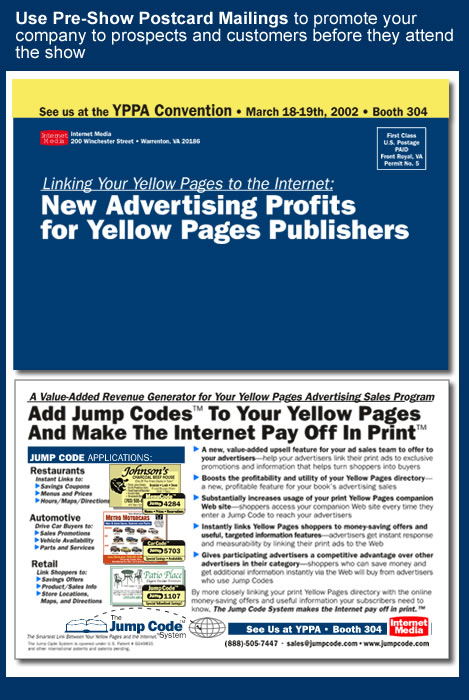
E-Mailing Show Announcements/Invitations to Existing Sales Prospects
Trade shows are a unique opportunity for your sales reps to meet with their existing sales prospects, and to close sales at the show. Obviously, many of your company’s existing prospects and customers, whose contact information is already stored in your company’s sales and marketing database, will also be attending the show, so you’ll need to promote your show appearance to them as well.
In addition to mailing your pre-show promotional postcard, plan on sending an HTML-format e-mail announcement to this group of prospects and customers in your sales database (see example below). The announcement should take the form of an invitation from your sales rep to the prospect or customer to visit your company’s booth at the show. It requires extra programming on the part of your Web staff, but the e-mail invitation should, if possible, be personally addressed to the prospect with a salutation in the body of the e-mail message.
Like printed postcards, e-mail promotional invitations should be sent to your current prospect and customer lists so they arrive approximately 1-1/2 weeks before the show date. You may also be tempted to send these e-mail messages to the attendee list you receive from the trade show management, but don’t—since attendees are likely to view your message as unsolicited spam e-mail.
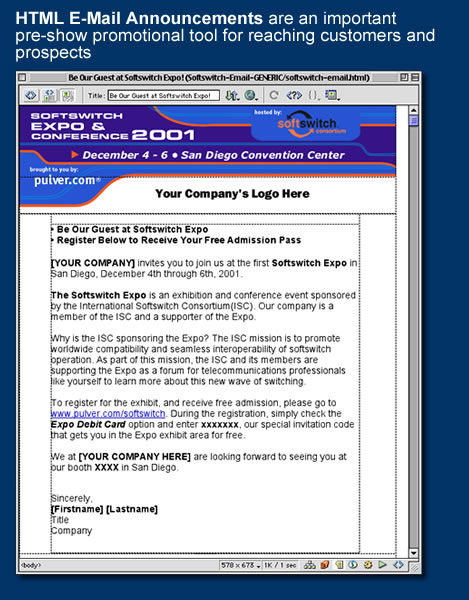
Advertising in Trade Show Dailies
Some of the largest trade shows publish “show dailies,” newspaper-format publications distributed to attendees once (or each day) during the show. Although this is an added promotional opportunity for your company, ad show dailies aren’t read by many attendees at the show, and they probably aren’t worth the extra expense compared to postcard mailings or other targeted pre-show marketing activities.
Sometimes trade show exhibitors are given a free ad placement in the show daily or show guide, which is included in the booth space rental for the show. If this is the case for your show, or if you’ve decided to pay the extra cost to advertise in the show daily, spec out a basic “tombstone” ad for this placement opportunity.
Because show dailies are handed out to readers who are more preoccupied with attending the show than reading your ad, your layout shouldn’t contain a lot of sales copy text: Just print your company name, logo, 4 or 5 sales bullet points, your company contact info, and booth number (see below).
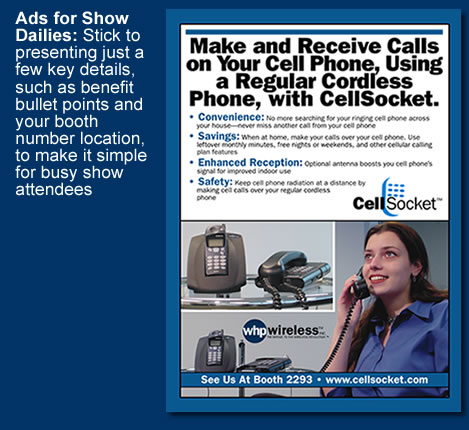
Printed Marketing Collateral for Trade Shows
As you prepare for your trade show, you’ll need to consider the print marketing deliverables for your company’s (or client’s) sales reps to hand out at the show. If your company is exhibiting at a major trade show with thousands of attendees, handing out thousands of copies of your company’s high-end, four-color 11 X 17 sales brochures could become a big expense.
Single-sheet flyers: A lower-cost alternative is a single-sheet flyer highlighting your company’s product or, better yet—a series of flyers, each covering a specific product, or group of products. These one-sided flyers can be printed in four-color on gloss stock for a relatively low price compared to more expensive pieces.
These flyers are inexpensive enough so you can place a stack of them out on the table of your trade show booth for show attendees to pick up as they pass by your booth. You can then reserve an “under the table” stash of your company’s higher-quality sales brochures for your sales reps to give to the more qualified prospects they speak to at the show.
You can also produce other types of single-sheet flyers to address certain aspects of your product’s sales benefits, functionality, or applications. For example, you could produce a “Q & A” sheet to answer the most-asked questions about your company’s product, or a series of single-sheet “Applications Profile” flyers to highlight the most common ways a prospect would use your product. Here, the idea is to have an inexpensive printed piece that a sales rep can hand out in your booth, on the spot, when the prospect asks the question that’s answered by the flyer (see below).

Prospect inquiry coupon: Produce printed coupons for show attendees to fill in to receive additional information on your company’s products. One type of card layout that works well here is a perforated card that presents your company’s basic promotional information on one half, and the fill-in portion for the prospect’s contact info on the other. Your prospect fills in the card, drops it off at your booth, and keeps the promotional half of the card. These cards can also be used in combination with a contest drawing, shown in the tabletop booth sign below, to provide an extra incentive for people to fill them out (see below).
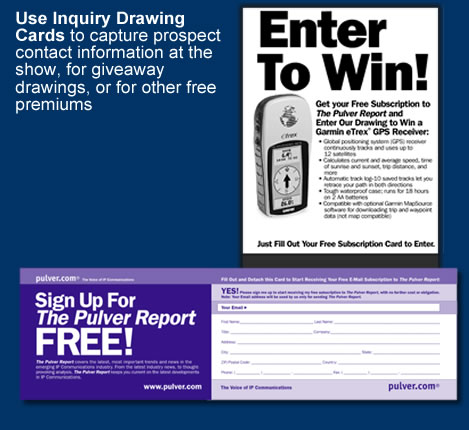
Trade Show Premiums and Drawings
When making show preparations, consider what, if any, trade show incentives to provide to attendees who visit your booth at the show. These generally fall into two categories:
Show premiums are “giveaways” imprinted with your company’s logo, handed out to anyone who visits your booth—T-shirts, coffee mugs, pens, etc.;
Show drawings are for more expensive items that a lucky attendee wins if they fill in and drop off one of your prospect inquiry cards, or drop their business card into a fishbowl at your booth. If they win the drawing, either at the end of each show day, or at the end of the entire show, they win the prize.
Many marketers feel obligated to hand out freebies and other premiums to anyone who visits their booth. These giveaways do nothing to help you collect mailing list information from interested prospects, and they attract the kind of show visitors who go from booth to booth, trolling for free stuff and who aren’t really interested in your product. If you’d like to hand out some premium giveaway items, by all means do so—but only for attendees who’ve provided contact info for your drawing.
A show drawing is a much better marketing incentive, in that there’s an equal exchange between your company and the prospect: You get the prospect’s contact info, and the prospect gets a chance to win the item. You may end up with contacts who aren’t currently prospects for your company’s products, but some of them may become prospects after receiving one of your standard follow-up mailings in the future.
Items used for show drawings needn’t be expensive. Generally, any hot, high-tech gadget or sporting item that can be purchased for under $500 (such as a hand-held GPS receiver, iPod, or fancy golf driver) that motivates your prospects to fill out an inquiry coupon, or drop their business cards in a fishbowl at your booth, will do.
Drawing table sign: If you’re having a drawing, you’ll also need an easel-backed table sign, such as the one in the graphic above, to place next to the fishbowl for the table in your booth.
Next week, in Part 3 we’ll cover some very important elements of trade show presentation and execution: Booth backdrop and signage design, booth sales videos, and trade show logistics for marketing managers . . .
Comments? Questions? Send them to me at: eric@realmarkets.net
_____________________________________________________________
Eric Gagnon (eric@realmarkets.net), is president of GAA, a sales and business development consulting firm, and is the author of The Marketing Manager’s Handbook, the master study guide for the Business Marketing Association’s Marketing Skills Assessment, Skill Builder, and Certification (MSA/B/C) programs.
For more information on The Marketing Manager’s Handbook, available to BMA members at a special discount, link to:
http://www.businessmarketinginstitute.com/book.html
_____________________________________________________________
Test, Train, and Build Your B2B Marketing Skills for Better Sales Success: BMA Announces New Assessment, Training, and Certification for B2B Marketing Managers
For more information on the new BMA Marketing Skills Assessment, Skill Building and Certification (MSA/B/C) training and professional development program, visit http://www.businessmarketinginstitute.com
